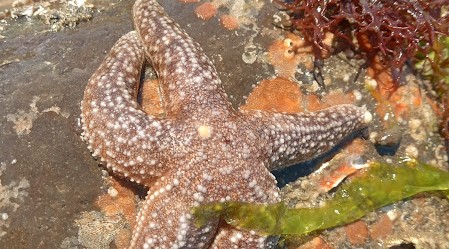Beginning at least as early as 2013, sea stars up and down the West Coast began succumbing to a mysterious disease that became known as sea star wasting syndrome. Afflicted sea stars would appear to deflate, losing limbs and eventually dissolving into a pile of goo. It sounds like a gruesome way to die–and the whole process could finish in a matter of days, leaving wake of devastation as the disease spread among at least twenty sea star species.
The real-world impact of wasting syndrome has become painfully visible on Pacific Northwest beaches over the last decade. On rocky shores that were once sprinkled with sea stars of various species and all different sizes, only the occasional big purple ochre star would be seen. Particularly concerning was the seeming virtual absence of young sea stars who could grow up to replenish the population. Within environmental and conservation circles, well justified fears that species like once-common ochre and sun stars might never recover ran rampant. Frustratingly, the exact causes of the disease have never been definitively determined; while there is likely a viral or bacterial pathogen involved, various environmental factors might also contribute to the proliferation of wasting syndrome.
There is clearly still much we don’t understand about wasting syndrome and its long-term effects on sea star populations. However, I personally am finding hope in my observations made while exploring Bellingham and Samish Bays in Northwest Washington this month. At some sites along the coast of Larrabee State Park, dozens of big ochre stars gather under boulders at low tide in numbers I can’t remember ever seeing before. And, turning over rocks at places like Bellingham’s Marine Park reveals many small-to-medium size young stars. We should always be cautious about drawing conclusions from such anecdotal data, and only rigorous scientific research can confirm for sure if the local sea star populations are bouncing back. But it sure feels like this is happening in real time.
If it’s true that at least some sea star species are rebounding, it would be huge news not only for these many-armed invertebrates but for the coastal ecosystem at large. Although they may not look fierce, sea stars are voracious keystone predators who consume a variety of intertidal zone invertebrates, including sea urchins. The disappearance of sea stars due to wasting syndrome and possibly other factors along parts of the West Coast has contributed to a boom in sea urchin numbers and a dramatic decline in the kelp and other seaweeds urchins feed on. The decimation of kelp forests impacts countless species that make their homes in these underwater forests.
My own observations about sea stars are not only anecdotal, but limited to a small segment of the coast in Northwest Washington. However, a wider increase in sea star numbers up and down the West Coast could allow kelp forests to start recovering. The ripple effects of this could potentially even affect the fight against climate change, as fast-growing kelp soaks up carbon.
It’s too soon to breathe a sigh of relief about sea stars just yet–but I can’t help fervently hoping future scientific studies will confirm what observations along the beaches fo Northwest Washington would at least seem to suggest is occurring. And, I now feel a surge of gratitude every time I spot another sea star reclining under a rock or creeping along the bay floor in shallow waters.



Leave a comment